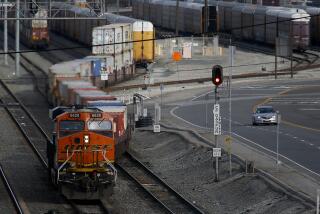L.A. Basin Gets ‘Double Whammy’ of Dirty Air
Just as one of the lightest smog seasons in years was winding down, nature and chemistry combined Monday to stain skies and sting eyes in the Los Angeles Basin with what one official called “a double whammy” of dirty air.
The South Coast Air Quality Management District called first-stage smog alerts for downtown Los Angeles, Pasadena and Glendora, meaning that the air in those areas was unhealthful for everyone.
“We expect some of these conditions to continue Tuesday, although we don’t expect the ozone levels to be so high,” AQMD spokesman Jim Birakos said.
Birakos said the smog “looked a lot worse than it was” in many areas, because the main pollutant was nitrogen dioxide, a gas which, in combination with natural fog and haze, created the “bourbon color” atmosphere that was so noticeable Monday.
Ordinarily the nitrogen dioxide is chemically changed by sunlight into invisible ozone, which is the most common type of Southern California smog, Birakos said.
The nitrogen dioxide level in downtown Los Angeles hit 200 on the Pollutant Standards Index at 10 a.m., while the ozone PSI downtown was 175.
The other first-stage alerts were called when ozone readings reached 200 in Pasadena and 205 in Glendora.
“This was one of (the) infrequent times when we had ozone and nitrogen dioxide episodes at the same time,” said Birakos, who called Monday’s problem “a double whammy.”
He explained that ozone smog is the usual type of air pollution during the heavy smog season, which runs from April through October. He said the unusually heavy concentration of nitrogen dioxide--produced by motor vehicle emissions--was the result of the fog and haze that blocked the sunlight that ordinarily converts the nitrogen dioxide into ozone.
Birakos noted that nitrogen dioxide and ozone--as well as carbon monoxide, the other common air pollutant--have the same unhealthful effects. The AQMD advises that children, elderly people and those with respiratory ailments curtail outside activities during both first- and second-stage alerts.
Despite Monday’s smog episodes, Birakos said, this season remains one of the best on record. The April-to-October season had the fewest smog alerts in five years, according to AQMD records.
Heavy early-morning fog forced the diversion of incoming flights from Los Angeles International Airport to Burbank-Glendale-Pasadena Airport between 2:45 a.m. and 6:45 a.m. Monday. LAX Superintendent of Operations John Hicks said that, fortunately, there was little air traffic during that time.
The National Weather Service forecast for Los Angeles and vicinity was for more dense fog after midnight. The fog should give way to haze and low clouds by mid-morning today, shifting to variable high clouds in the afternoon. High temperatures are expected to range from the mid 70s in downtown Los Angeles to the mid and upper 80s in the valleys.
More to Read
Sign up for Essential California
The most important California stories and recommendations in your inbox every morning.
You may occasionally receive promotional content from the Los Angeles Times.










